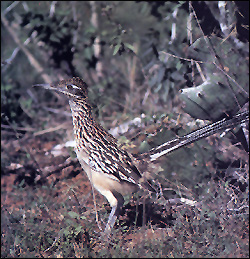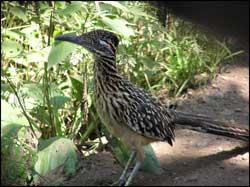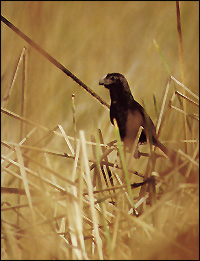Roadrunners, Cuckoos, and Anis
One of the strangest families in the bird world is the one that includes the roadrunner, cuckoos, and anis (AH-nees). In fact, the appearance, food habits, and other characteristics of these three species are so different it is hard to believe they belong to the same family. However, ornithologists (or-na-THAL-ah-jists), people who study birds, consider more than just outward appearances when they group birds. They recognize that despite their many differences, these birds also have many characteristics in common. All of them are slender birds with rounded wings, curved bills, and long floppy tails. Their tail feathers also are graduated in size, with the shortest ones on the outer edges, and the males and females within each species look alike. Another family trait can be seen in the tracks, which look like X's. This strange track, which makes it hard to tell whether the birds are coming or going, occurs because their feet have two toes pointing forward and two pointing back. This arrangement enables them to climb and grasp.

The roadrunner's running speed has been clocked at about fifteen miles per hour.
The roadrunner and its track have inspired many beliefs and superstitions. J. Frank Dobie, noted folklorist and perhaps the roadrunner's greatest fan, wrote that the Pueblo Indians of New Mexico drew the bird's track on the ground near the tent of their dead to mislead evil spirits trying to follow the departed soul. To ward off the henchmen of the "Bad God," Plains Indians often hung the whole skin of a roadrunner over their lodge door. The Tarahumare Indians of the Sierra Madre claimed their running skill was a result of eating meals that included roadrunner meat.
Luck, both good and bad, also has been attributed to the roadrunner. One of these birds living near a home brought the residents good fortune. One crossing the road from left to right brought good luck, but one crossing in the opposite direction brought bad luck. Early travelers also believed that if a lost man found and followed a roadrunner or its tracks, he would be led to a trail. Since the roadrunner is known to hunt for insects in the vegetation along roads, deer trails, and animal pathways, this belief has a basis in fact.
Speaking of food habits, the roadrunner will eat anything from insects to small mammals, as well as fruits, seeds, and prickly pear. The bird is particularly fond of lizards and snakes, including small rattlesnakes, and its method of killing them could be considered another unusual characteristic of the bird. To kill a snake, the road-runner circles around it. Using speed, agility, and quick leaps into the air to stay clear of the snake's fangs, the bird rushes in and stabs the snake with its pointed beak. Repeated blows stun the snake so it can be seized and slammed against the ground. The bird then pounds it repeatedly against the ground or a rock until the bones in the snake's head and body are broken or crushed. Lizards and other large prey also are killed and softened in this manner.
It is especially interesting to watch a nest-bound young being fed a snake brought by one of its parents. When the snake is too long, the parent forces as much of the reptile down the young one's gullet as possible, leaving the excess hanging outside its beak. As the young bird's digestive juices work on the swallowed portion, the remainder slowly works its way inside. In a matter of hours the entire snake is eaten. Adults also have been seen running around with partially swallowed snakes hanging out of their mouths.

The roadrunner's short, rounded wings allow it to glide to the ground from tree perches or leap into the air when startled.
The roadrunner, a favorite with many people, is somewhat of a tourist attraction in the Southwest. Also known as chaparral cock, ground cuckoo, or paisano, the roadrunner usually is found on the ground. It uses its wings to leap into the air when startled or to glide to the ground from perches. Its fitful flight is seldom long and usually consists of a spectacular leap into the air followed by a crashing dive into dense brush for concealment. The rest of the time the bird can be found running across the ground at speeds up to fifteen miles per hour.
Perhaps because of the well-known cartoon character constantly being chased by the coyote, most people picture this bird only in a desert-type habitat. However, the roadrunner is squally at home among the swamplands, tall pines, and magnolias of East Texas, the limestone outcroppings and brush of the Hill Country, and the mesquites and prickly pear of West Texas. All the bird needs is some bare ground with more or less scattered trees and bushes where it can walk around and catch food.
Its white eggs are laid in a nest of sticks hidden in a cactus, tree, or thorny bush. Young are raised on such delicacies as lizards, snakes, scorpions, and insects. For the first twelve days, as one parent guards the nest and young, the other one hunts. When the hunting adult approaches the nest with food, the guardian adult leaves to take its place hunting. These duties are switched with each return trip until the time when the size and hunger of the young birds force both adults to hunt at the same time. After the young are about two weeks old, the adults seldom bring anything smaller than a young lizard as food. The young are able to leave the nest three weeks after hatching, but they stay close by so the adults can feed and train them for a while longer.
Moving along to the next members of this strange family, we come to the cuckoos. Most common of the three cuckoo species is the yellow-billed cuckoo, which nests throughout Texas and is found over most of the United States. It can be recognized by the yellow lower mandible on its slightly curved bill and the large white spots on the underside of its dark tail feathers. Its body is dull brown above and white below with reddish wing coloration. Graceful and swift on the wing, the yellowbill slips quietly through its leafy habitat. Birders seldom see it on an exposed limb since it prefers to skulk in the leaves, searching for insects and caterpillars. Its favorite food is caterpillars, including the hairy species that most birds pass up. The hairy spines often coat the inside of the bird's stomach. Because they eat many of the caterpillars that damage trees, such as the tent caterpillar, cuckoos should be welcome guests in yards and orchards. They also eat locusts, beetles, bugs, grasshoppers, ants, wasps, an occasional frog or lizard, and wild fruits, such as raspberry, elderberry, and mulberry.

The groove-billed ani is probably the least known member of the cuckoo family.
As its name implies, the less colorful black-billed cuckoo has a black bill. It also has a narrow, red eye-ring, but lacks the yellowbill's reddish coloration in its wings. The tail spots, found on the underside of its olive-brown tail, are much smaller than those of the yellowbill. Trying to spot the blackbill is more difficult than seeing the yellowbill since it is an even greater recluse. It prefers the dense woodlands along streams, ponds, and lakes, the dense borders of meadows and forests, or the deep thickets and groves of coastal prairies. Although the blackbill visits orchards and gardens, it still remains well hidden from interested observers as it migrates through the eastern and central portions of the state. It is as much of a caterpillar hunter as the yellowbill, but the blackbill also eats a variety of grasshoppers, crickets, beetles, other insects, spiders, and, occasionally, wild fruits.
Yellow-billed and black-billed cuckoos usually build nests of twigs in bushes and trees and raise their own young. However, in areas where both are found, they may lay eggs in each other's nests. Occasionally the blackbill lays its eggs in the nests of other smaller woodland birds. This act, known as social parasitism, is a common practice among the Old World cuckoos. When the young cuckoo hatches, it usually pushes nest mates or unhatched eggs belonging to the foster parents out of the nest to make more room for itself. Foster parents may have a difficult time gathering enough food for their hungry, substitute offspring, which may be larger than they are.
The third member of this species, the rare mangrove cuckoo, does not make its home in Texas. In fact there has been only one recorded Texas sighting, back in 1964 on a Christmas bird count. This bird makes its home among the mangroves of the Florida Keys and along the southwest coast of Florida north to Tampa Bay. It also inhabits the West Indies, the mangrove belts of the lowlands in Middle America, the north coast of South America, and many off-shore islands. It has bright, buffy underparts and a black mask.
Because their chuckling call is heard most frequently on cloudy days, cuckoos are called "rain crows" by many people.
The groove-billed ani of South Texas and the smooth-billed ani of southern Florida are probably the least known members of this family and the oddest. They could easily be mistaken for blackbirds or grackles if it were not for their high, puffin-like beaks. As their name indicates, the groove-billed ani has grooves on its bill that are visible at close range, and the smooth-billed ani has none. In Texas, the birds stay in the thickest thornbrush they can find, choosing patches of Texas ebony, mesquite, huisache, and retama bushes. However, in Mexico and Central America these birds seem to be more at home in open pastures with only scattered bushes. Here they may be found in small flocks on the ground eating insects. They have learned to feed around the feet of grazing livestock, catching the insects disturbed by the cattle's hooves as they move about. Many insects can be found in this manner without too much effort on the part of the birds. Although anis eat mainly insects and an occasional lizard, they also will eat fruit, berries, and other vegetation, especially during the dry season. Their reputation as tick eaters is grossly exaggerated, but they do perch on cattle and eat some ticks from the animals.
Anis are weak fliers, and it is funny to watch them flutter around in a strong wind. To take flight, the ani leaps into the air, gives a few quick flaps, sails for a couple of feet, flaps some more, and then sails again. When the bird lands, its tail flops forward over its back and almost knocks it off its perch. Despite its reputation as a weak flier and a resident of the tropics, the groove-billed ani has made startling appearances in such nontropical spots as Minnesota, Nebraska, and Kansas.
When nesting, the anis may follow the normal pattern of one pair of birds to one nest, or they may share a communal nest. In the latter method, two or more female anis lay their pale greenish blue eggs in the same untidy basket of twigs, leaves, and grass hidden in a thorny bush and then take turns incubating them. When the young hatch, all adults, males and females alike, share the task of feeding them. Some baby birds are considered cute, but the young ani with its black skin and huge bill can hardly qualify as appealing.
Even though the roadrunners, cuckoos, and anis would never win a "most beautiful" contest, they all could qualify for "personality" or "most unusual" awards. So the next time you laugh at the antics of a roadrunner, hear the cuc cuc-cuc of the rain crow, or catch a glimpse of the ani, you will know that you have had a chance to meet a member of the unique Cuculidae family.
Ilo
Hiller
1989 – Roadrunners, Cuckoos, and Anis: Introducing Birds to Young
Naturalists. The Louise
Lindsey Merrick Texas Environment
Series, No. 9, pp. 43-47.
Texas A&M University
Press, College Station.